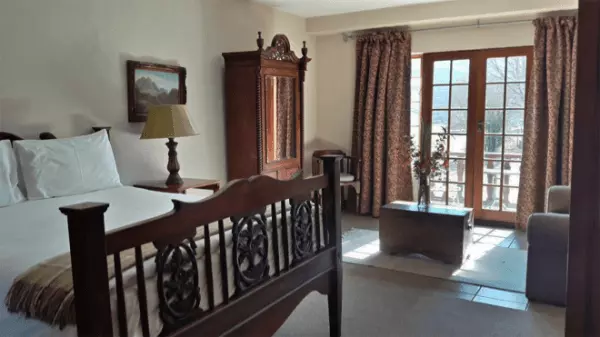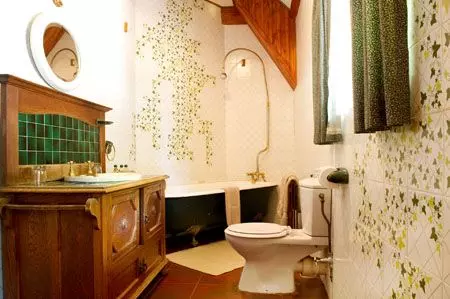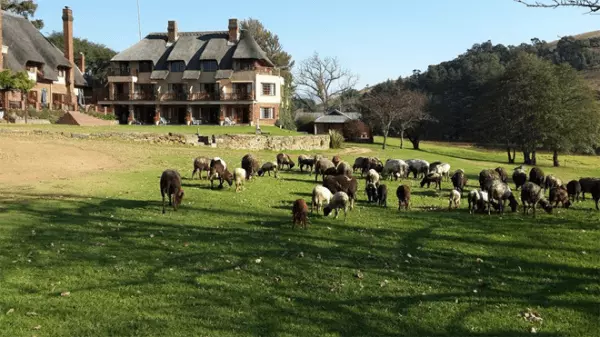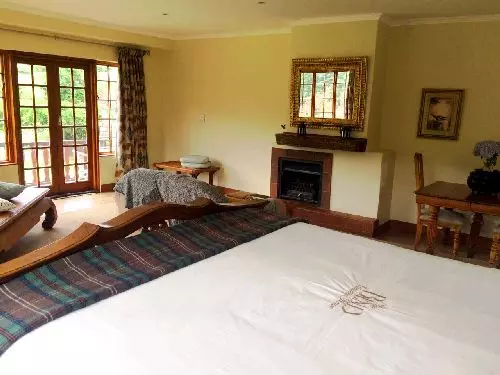A family friendly venue for functions, as well as outdoor activities such as mountain bike trails, trout fishing and hiking.
The Bend was first developed by the Doney family in 1876. Alfred Doney arrived in South Africa as an indentured coachman and after completing his contract he moved to the Nottingham Road area which then formed part of the district of Weenen. The family first made their home in a cluster of wattle and daub rondavels directly across the river from the present House.
The remains of these buildings can still be found together with what appear to be the graves of children. These provide us with a sad record of the hardship that these hardy settlers endured. The present owners met the granddaughter of the family, then in her 80’s when they bought in 1983. She had been granted the usufruct of a portion of the farm when it changed hands in the 1920’s.
The next owner was a financier from Johannesburg, a Mr. Montague Simpson. He owned the farms Benmore and Parkmore on the outskirts of Johannesburg, today the heart of Sandton. He bought The Bend in 1926 and initiated a programme of grand design – all the stone outbuildings and the complicated system of drainage were the result of his energies. He favoured the breeding of Ayreshire cattle and Landrace pigs. These animals were so highly regarded by him that the pig sties had Oregon pine cottage pane windows!
His cattle were probably the only cows in South Africa to be subjected to “orthodontics” – Montague required that their horns conform exactly to the breed specifications and the rings that were used to shape the horns during feeding can still be seen in the area behind the Chapel.The pond in front of the house provide the opportunity for him to parade his animals before a suitably admiring audience – the animals would be led around this feature while his guests sipped G&T’s and Pimms in true colonial splendor.
Mrs. Simpson was an avid Flyfisher woman – but could not cast! She enjoyed the services of a Gilly whose job it was to take the fly and walk downstream from the bridge until he had taken up all the line. The fly was then flung into the current and Mrs. Simpson gracefully reeled it in. We do not know how successful this method of trout fishing was, but it served to encourage her to remove herself from the glamour of her life in Johannesburg on occasion.
Many of the oldest members of the community learnt to swim in the pond as children. It is easy to picture a way of life on The Bend that was as close to the “Out of Africa” experience as it could be in this colony of Great Britain – no wonder that to this day it is still known as “the Last Outpost”. Montague relinquished ownership of The Bend in 1956.
The next 27 years were relatively uneventful and a number of farmers in turn held the property. Little further construction took place and the pace of life reflected that of serious commercial dairymen and sheep farmers.The situation changed in 1983 – 2 enthusiastic young people, Jose Manuel Holgado (a mining engineer) and Sheila Thornhill Holgado (a language student and teacher) took over together with their young family. Things reverted to the days of heady construction. Together they designed their ideal home and set about making it a reality. Our preference would have been to restore rather than rebuild. However as the original homestead had been built from the redundant 1st World War Officer’s mess in Durban it proved impossible to save the old house.
The internal doors were saved, as were the Oregon pine floor boards. The latter became the magnificent staircase you see on arrival. The workmanship of the staircase, the panelling and the ceilings are a monument to the skill of Ron Fourie who spent 3 years helping the Holgados’ achieve their dream. What you see around you today is the work of rather bemused farm labourers. The creation became a source of pride to all who worked on it and we all took time out to stand back and admire each small step towards completion.
The story of Dawid Somfuso Makhaye is evidence of the benefit of living in this area. Dawid joined the staff of The Bend in 1918. He served with the Allied Forces in Egypt during the 2nd World War. At the age of 98 he could be seen riding his equally mature stallion Captain around the district. Dawid died at The Bend in the arms of his family at the age of 105.
The Holgados’ turned The Bend into one of the most productive farms in the area: 200 hectares under irrigation, 400 beef cows, a 220 unit Charolais stud, seed potatoes, a million seedlings of cabbage, cauliflower and broccoli and lastly, 2000 Dohne/Border Leicester sheep! The farming activities gave rise to much satisfaction and an almost equal degree of anxiety. The wisdom of Mr. Bunty Christie from whom the Holgados’ had bought proved true – to make a small fortune out of farming, you only have to start with a large one! We loved every minute of it.
By 1996 the children had grown up and family circumstances led to Jose’s return to Spain. It was time to rethink the nature of The Bend and its significance for the Holgado family. This was the moment when we decided to change direction and to open The Bend for the enjoyment of a wider audience. We initiated the development of the Residential component and established the Country House. Sheila was confident that this would succeed as The Bend had a long tradition of hospitality.
VISIT OUR WEBSITE FOR MORE INFO






